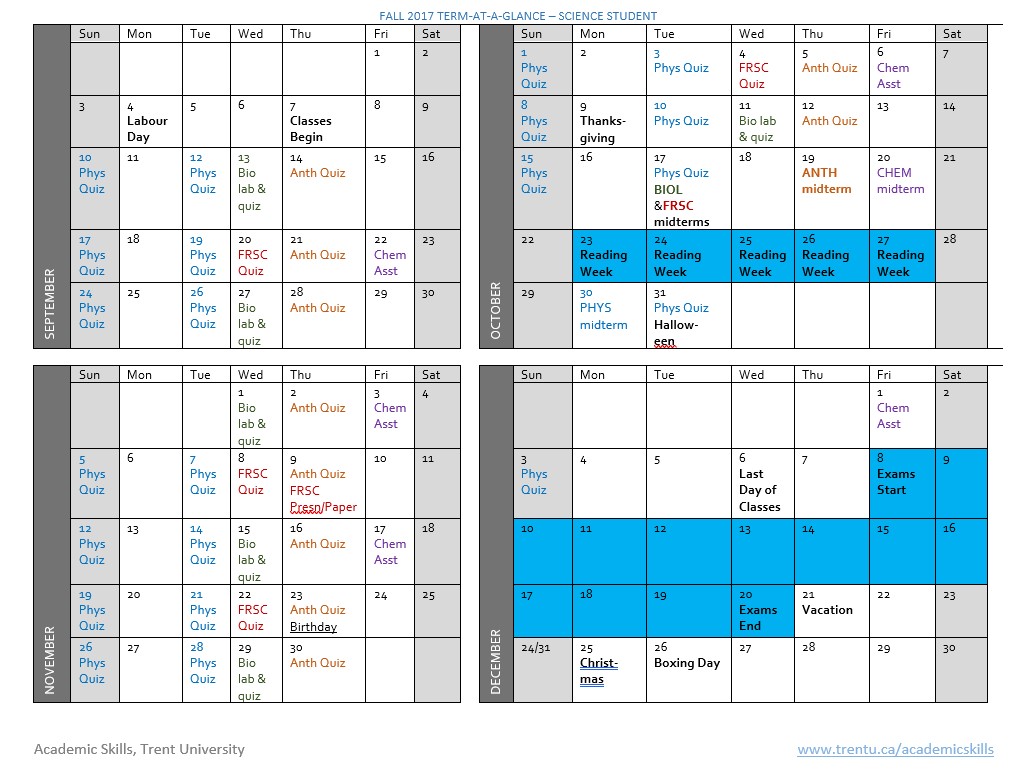Creating a long term plan will allow you to know when your major assignments are due and whether you have crunch periods during which you have many assignments due at once. A calendar or due date spreadsheet can be excellent tools to use; these tools allow you to see all the months of a term without turning a page or changing screens.
Using a Term-at-a-Glance Calendar Effectively
You can download a term-at-a-glance calendar or use a four-month wall calendar, whichever is more convenient for you.
- Go through the course outline for each class and carefully note all assignment due dates and exams. Put these dates onto your 4-month calendar. You can use a different colour for each course if this helps. Keep this calendar in plain view for quick reference.
- Be sure to include important birthdays and planned trips home as you often need to work around them.
- Identify your “crunch times,” periods when you have multiple assignments or exams. Plan for these times by deciding when you need to start each assignment in order to get it done in time.
- Don’t forget to note Reading Week in your calendar; it’s a great time to catch up or get ahead!
- Make intermediate deadlines for different stages of each assignment and put these on your calendar. You can determine your intermediate deadlines (or mini deadlines) by following our steps for Assignment Analysis.
- Remember that learning to make and follow a plan takes time. Be flexible. If a week looks full, try to move some work to an earlier week. Don't worry if you need to adjust your calendars a few times. That's part of the trial-by-error process, and it's useful.
Sample Term-at-a-Glance Calendar

Due Date Spreadsheet
This due date spreadsheet template provides a countdown to your assignment deadlines, supporting you with prioritizing and planning assignment work.
Using a Due Date Spreadsheet Effectively
- Go through the syllabus for each class and carefully note all assignment due dates and exams. Put these dates into your Due Date Spreadsheet.
- You can use a different colour for each course if this helps.
- Add as much detail that is helpful to you: weight/worth, notes about the task, status (in progress, complete).
- Note that the 'Days until due' (Column E) in the template has a formula in place to calculate the number of days until the assignment is due. Simply add your due dates to Column C, and the countdown column will update.
- If you notice certain crunch periods where multiple tasks are due around the same time, you might consider adding your own start dates or mini due dates.
- Save your spreadsheet in a place where you can view it often for quick reference.
Assignment Planning
We often put off a task because we don’t appreciate how much time it will take to complete, or we don’t know where to start. By breaking down an assignment into smaller steps, you can better understand where to begin your assignment and when you should start (and complete) it. See how you can break your assignment into 10 steps in our guide to Planning Your Assignment.
In the example below, the assignment is broken into specific tasks and these tasks are spread out over the course of 18 days. This breakdown allows a student to approach the assignment thoughtfully and provides them to complete work for other courses without the stress of completing the assignment. You can download a template to help you with this task.
Sample Assignment Plan
|
Assignment |
Step/Task |
Estimated time to complete |
Complete task by |
|---|---|---|---|
|
Research Paper: 6-8 pages min. 6 sources Due Oct 10
|
Read assignment instructions Select a topic Brainstorm ideas |
0.5 – 1 hr |
Sept 22 |
|
Preliminary research
|
1-2 hrs |
Sept 22 |
|
|
Research Questions Working Thesis Question |
0.5-1hr |
Sept 24 |
|
|
Research Find Sources Read Sources Take notes |
6-10 hrs
|
Start Sept 24 Finish Sept 30 |
|
|
Thesis & Outline |
0.5-1 hr |
Oct 1 |
|
|
First Draft |
6-10 hrs |
Start Oct 1 Finish Oct 6 |
|
|
Revise (second draft) |
2-3 hrs |
Oct 7 |
|
|
Edit (third draft) Proofread |
2 hrs |
Oct 9 |
|
|
Submit/Deadline |
|
Oct 10 |

